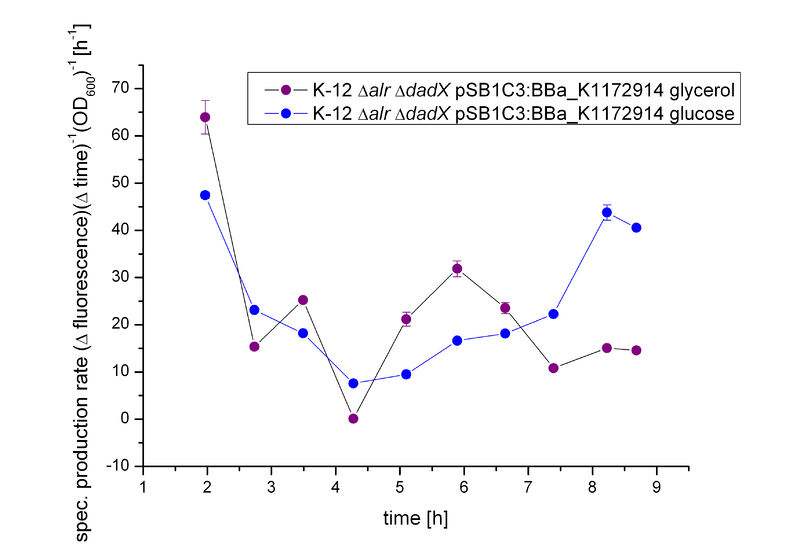Difference between revisions of "Part:BBa K1172915"
| Line 10: | Line 10: | ||
<span class='h3bb'>Sequence and Features</span> | <span class='h3bb'>Sequence and Features</span> | ||
<partinfo>BBa_K1172915 SequenceAndFeatures</partinfo> | <partinfo>BBa_K1172915 SequenceAndFeatures</partinfo> | ||
| + | |||
| + | ==='''Biosafety system TetOR alive'''=== | ||
| + | <br> | ||
| + | <p align="justify"> | ||
| + | Combining the genes described above with the Biosafety-Strain K-12 ∆''alr'' ∆''dadX'' results in a powerful device, allowing us to control the bacterial cell division. The control of the bacterial growth is possible either active or passive. Active by inducing the ''tetO'' operator with tetracycline and passive by the induction of L-rhamnose. The passive control makes it possible to control the bacterial cell division in a defined closed environment, like the MFC, by continuously adding L-rhamnose to the medium. As shown in Figure 7 below, this leads to an expression of the essential alanine racemase (''alr'') and the TetR repressor, so that the expression of the RNase Ba is repressed. </p><br> | ||
| + | [[File:IGEM Bielefeld 2013 Biosafety System M 2.png|600px|thumb|center|'''Figure 7:'''Biosafety-System ''TetOR alive'' in the presence of L-rhamnose. The essential alanine racemase (Alr) and the repressor TetR are expressed, resulting in a repression of the expression of the RNAse Ba. Consequently the bacteria show normal growth behavior.]] | ||
| + | <br> | ||
| + | <p align="justify"> | ||
| + | In the event that bacteria exit the defined environment of the MFC or L-rhamnose is not added to the medium any more, both the expression of the alanine racemase (Alr) and the TetR repressor decrease, so that the expression of the toxic RNase Ba (Barnase) begins. The cleavage of the intracellular RNA by the Barnase and the lack of synthesized D-alanine, caused by the repressed alanine racemase inhibit the cell division. Through this it can be secured that the bacteria can only grow in the defined area or the device of choice respectively. </p><br> | ||
| + | |||
| + | [[File:IGEM Bielefeld 2013 Biosafety System M ohne Rhamnose+ 2.png|600px|thumb|center|'''Figure 8:'''Active Biosafety-System ''TetOR alive'' outside of a defined environment lacking L-rhamnose. Both the expression of the alanine racemase (Alr) and TetR repressor are reduced and ideally completely shut down. In contrast, the expression of the RNase Ba (Barnase) is turned on, leading to cell death by RNA cleavage.]] | ||
| + | <br> | ||
[[File:Team-Bielefeld-Biosafeyt-System_TetORalive-TetOGFP-OD.jpg|600px|thumb|center|'''Figure 12:''' Characterization of the bacterial growth of the TetO promoter with GFP (<bbpart>BBa_E0040</bbpart>) in the Biosafety-Strain K-12 ∆alr ∆dadX. The M9 media was supplemented with 5 mM D-alanine. It can be seen, that the bacteria grow faster on M9 minimal media glucose than on M9 minimal media glycerol. ]] | [[File:Team-Bielefeld-Biosafeyt-System_TetORalive-TetOGFP-OD.jpg|600px|thumb|center|'''Figure 12:''' Characterization of the bacterial growth of the TetO promoter with GFP (<bbpart>BBa_E0040</bbpart>) in the Biosafety-Strain K-12 ∆alr ∆dadX. The M9 media was supplemented with 5 mM D-alanine. It can be seen, that the bacteria grow faster on M9 minimal media glucose than on M9 minimal media glycerol. ]] | ||
Revision as of 13:56, 29 October 2013
Biosafety-System TetOR alive (TetR)
Biosafety-System TetOR alive
Sequence and Features
- 10COMPATIBLE WITH RFC[10]
- 12INCOMPATIBLE WITH RFC[12]Illegal NheI site found at 1156
- 21INCOMPATIBLE WITH RFC[21]Illegal BglII site found at 1080
Illegal BamHI site found at 1782 - 23COMPATIBLE WITH RFC[23]
- 25INCOMPATIBLE WITH RFC[25]Illegal AgeI site found at 1198
Illegal AgeI site found at 1498 - 1000INCOMPATIBLE WITH RFC[1000]Illegal BsaI.rc site found at 955
Illegal BsaI.rc site found at 2774
Biosafety system TetOR alive
Combining the genes described above with the Biosafety-Strain K-12 ∆alr ∆dadX results in a powerful device, allowing us to control the bacterial cell division. The control of the bacterial growth is possible either active or passive. Active by inducing the tetO operator with tetracycline and passive by the induction of L-rhamnose. The passive control makes it possible to control the bacterial cell division in a defined closed environment, like the MFC, by continuously adding L-rhamnose to the medium. As shown in Figure 7 below, this leads to an expression of the essential alanine racemase (alr) and the TetR repressor, so that the expression of the RNase Ba is repressed.
In the event that bacteria exit the defined environment of the MFC or L-rhamnose is not added to the medium any more, both the expression of the alanine racemase (Alr) and the TetR repressor decrease, so that the expression of the toxic RNase Ba (Barnase) begins. The cleavage of the intracellular RNA by the Barnase and the lack of synthesized D-alanine, caused by the repressed alanine racemase inhibit the cell division. Through this it can be secured that the bacteria can only grow in the defined area or the device of choice respectively.



Characterization of the Biosafety-System TetOR alive
Conclusion of the Results
File:Team-Bielefeld-Biosafety-System-TetORalive-Overview.jpg





